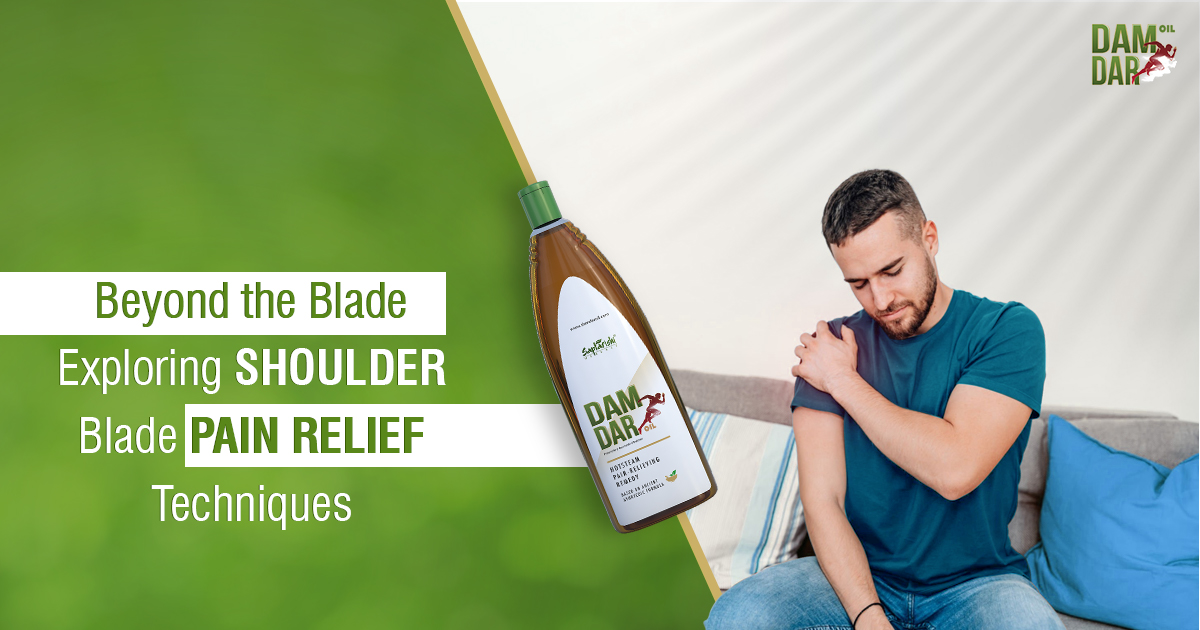Exploring Shoulder Blade Pain Relief Techniques

Alright, let's talk about that annoying shoulder blade pain that some call back shoulder pain. You know, that achy, nagging feeling that just won't quit? And, if you have pain in both shoulders, you are in double trouble!
So, why do we get this pain? It could be due to poor posture when we're slouching over our desks or binge-watching our favorite channel. Or, maybe overuse shoulder muscles at the gym, or typing away furiously at the keyboard for hours on end. And let's not forget about an injury or a clumsy move that may make the shoulder blades achy.
But fear not, all those shoulder blade pain sufferers, relief is on the way! And guess what? You don't need to resort to popping pills or going under the knife to get it. Nope, we're going full-on natural with this one.
Precisely, the shoulder blades, or scapulae, are the triangular-shaped bones on the upper back. They play a crucial role in the movement of the arms and shoulders, working as attachment points for various muscles. When the muscles, tendons, or ligaments surrounding the shoulder blades become strained, irritated, or inflamed, it can result in pain and discomfort.Shoulder pain symptoms include aching, stiffness, limited range of motion, weakness, swelling, and difficulty performing daily tasks or lifting.
Common Causes of Shoulder Blade Pain
Several factors can cause to back shoulder muscle pain, including:
Poor Posture: Long periods of slouching or sitting with rounded shoulders can strain the muscles around the shoulder blades, leading to pain and stiffness.
Muscle Tension and Overuse: Repetitive movements or activities that involve the arms and shoulders, such as lifting heavy objects or working at a computer for extended periods, can cause muscle tension and overuse injuries. This is a common cause of front shoulder pain.
Trauma or Injury: Falls, accidents, or sudden impacts can injure the muscles, ligaments, or bones in the shoulder blade area, resulting in acute or chronic pain.
Medical Conditions: Conditions such as rotator cuff injuries, arthritis, nerve compression, or referred pain from the neck, upper back or even in some cases problems with the gallbladder or liver can manifest as shoulder nerve pain.
Shoulder Blade Pain Relief Techniques
If you are looking for the answer to how to get rid of shoulder pain, these are some of the techniques you can apply:
Stretching and Range of Motion Exercises: Gentle stretching exercises can help alleviate tension and improve flexibility in the muscles surrounding the shoulder blades. Focus on movements that target the shoulders, upper back, and neck, such as shoulder rolls, arm circles, and neck stretches.
Posture Correction: Be conscious of your posture throughout the day, especially when sitting or standing for long periods. Sit up straight with your shoulders relaxed and your spine aligned. Consider using ergonomic furniture or supportive cushions to maintain proper posture.
Heat and Cold Therapy: Applying heat packs or warm compresses to the affected area can help relax tense muscles and increase blood flow. Alternatively, cold therapy with ice packs or cold compresses can reduce inflammation and numb the area to alleviate pain.
Massage and Myofascial Release: Gentle massage techniques, such as kneading or rolling movements, can help release tension and improve circulation in the muscles around the shoulder blades. Foam rolling or using massage balls can also target trigger points and tight areas.
Strengthening Exercises: Building strength in the muscles surrounding the shoulder blades can provide stability and support, reducing the risk of injury and relieving pain. Include exercises that target the upper back, shoulders, and core muscles, such as rows, shoulder blade squeezes, and plank variations.
Mind-Body Techniques: Practices such as yoga, tai chi, or mindfulness meditation can help reduce stress, tension, and pain perception. These mind-body techniques promote relaxation, body awareness, and emotional well-being, which can positively impact shoulder blade pain.
These may be included as part of your shoulder pain treatment at home. But, if shoulder bone pain persists or worsens despite self-care measures, consider seeking professional help from a healthcare provider or physical therapist. They can evaluate your condition, provide personalized treatmentadvice, and offer additional interventions such as manual therapy or corrective exercises.
Shoulder Pain Treatment in Ayurveda
Wondering how to reduce shoulder pain with Ayurveda? Herbal shoulder pain medications or decoctions made from dashmool, rasna, guduchi, help alleviate pain and inflammation in the shoulder joints.Guggulu, pipali, and sunthi are known for their anti-inflammatory and pain-relieving effects, making them beneficial for managing shoulder pain associated with arthritis and musculoskeletal disorders. Herbal oils commonly used in Ayurvedamassage therapy contain ingredients that help relax the muscles, improve blood circulation, and reduce inflammation in that region.
Conclusion
Dealing with shoulder blade pain can be tough, but there are ways to feel better. By doing simple things like stretching, fixing your posture, and using heat and shoulder pain medicine. By doing exercises to make your muscles stronger, you can ease the pain and move better. Just remember to pay attention to how your body feels, take care of yourself, and ask for help from a pro if you need it. With the right approach, you can beat that shoulder blade pain and feel like yourself again.
